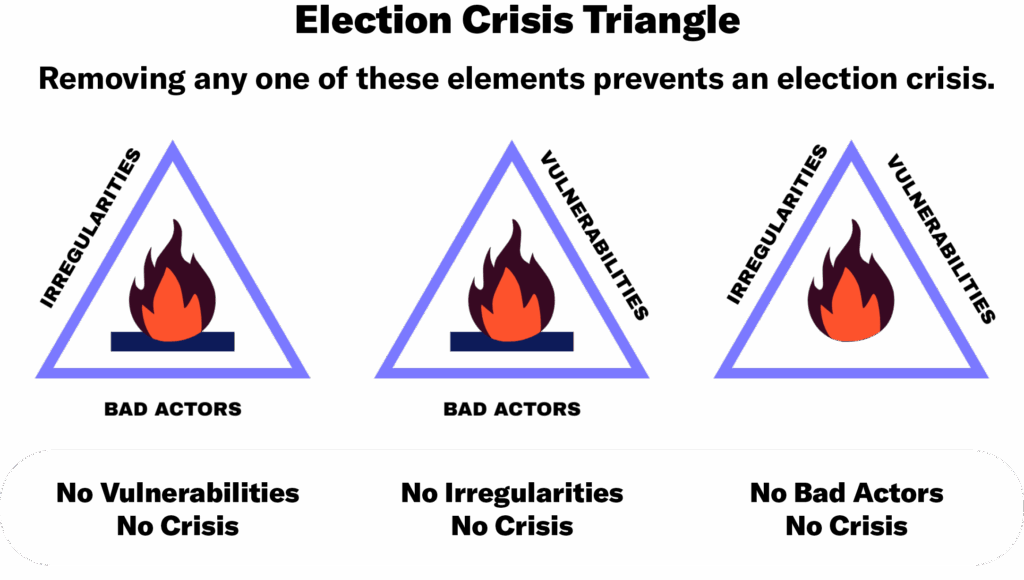Report
States on Offense: The Path Forward to Strengthen Our Elections
Executive Summary
In recent election cycles, politically motivated actors have exploited irregularities (real or perceived) in election administration to cast doubt on the reliability of results. These efforts threaten to prevent eligible voters from casting their ballots or cause lawfully cast ballots to be thrown out. In the most alarming cases, losing candidates and/or their allies have challenged legitimate election results through unscrupulous lawsuits. In general, the most severe attacks on election results typically follow a two-step pattern:
- Before and during the election: Bad-faith actors identify issues in state laws governing elections — often based on a deliberately skewed version of events. They then use these gaps as a pretext for spreading false narratives, suggesting that people should not trust our elections and that the results are likely to be flawed. These vulnerabilities lay the groundwork for justifying post-election interference.
- After the election: Bad-faith actors, often losing candidates themselves, exploit vulnerabilities in state laws and procedures governing how votes are verified (canvassing) and how winners are finalized (certification) to contest election results and undermine the expressed will of the voters.
Just as election laws differ in each state, so too do the opportunities for exploitation throughout the process laid out above. Depending on a state’s specific laws and procedures, politically motivated actors may begin laying the groundwork for challenging election results several months before Election Day. Recent challenges, such as the 2024 North Carolina state Supreme Court race, have dragged on for months after Election Day. These challenges leave critically important results uncertain and eligible voters anxious about whether their lawfully cast ballots will ultimately be counted.
This pattern of elements combines to create an election crisis that functions similarly to the three elements needed to start a fire.
A fire requires fuel, oxygen, and heat to burn. Removing any one of those elements prevents a fire. Likewise, election crises have their own “fire triangle” of elements required to ignite. An election crisis is likely if there are:
- Real or perceived pre-election irregularities that bad actors can twist into a pretext for election manipulation;
- Vulnerabilities in state election laws or procedures that can be exploited by losing candidates to halt certification of valid results; and
- Bad actors who are willing to buck democratic norms to undermine the will of the voters.

In this report, we highlight how bad actors may exploit vulnerabilities in state law or procedures to sow distrust and lay the groundwork for subsequent attempts to undermine voter will. Many of the issues and narratives that bad actors spin around elections are not rooted in reality, but the impact on public confidence is very real. Shoring up state laws and election processes can minimize or eliminate these falsehoods from gaining traction. By adding transparency, consistency, and clarity throughout the pre- and post-election process, lawmakers can boost voter confidence and significantly reduce the frequency of challenges that seek to undermine elections.
Read the Full Report
Learn how bad actors may exploit vulnerabilities in state law or procedures to sow distrust and lay the groundwork for subsequent attempts to undermine voter will.
We offer our policy recommendations for state officials to mitigate, preempt, and eliminate these vulnerabilities both before and after elections, thereby strengthening state elections and defending the will of the voters from partisan interference ahead of the 2026 and 2028 elections.
Policy Fixes to Strengthen Our Elections
- Ensure voter lists are accurate and eligible voters are not removed from the rolls by strengthening list maintenance procedures, tightening rules for mass registration challenges, and implementing safeguards against erroneous removals.
- Ensure the smooth casting of ballots and that results are timely by preventing last-minute law and policy changes, limiting disruptions at polling places, and allowing for pre-processing and other transparency measures to speed up results reporting and public confidence.
- Ensure results are accurate and trusted by implementing high-quality audits during canvassing, implementing voter-verifiable systems, and increasing visibility and transparency during the counting and canvassing process.
- Ensure the results are certified by strengthening the rules for certifiers, ensuring there are remedies and alternative certification paths should a body refuse, and tightening post-election judicial processes and creating accelerated pathways for resolution to post-election lawsuits and protests.
Enacting these policy fixes will benefit all voters, candidates, and election officials across geographic and partisan lines. These policies will ensure that election outcomes reflect the will of the voters — and not a few holdouts in a conference room or courtroom.